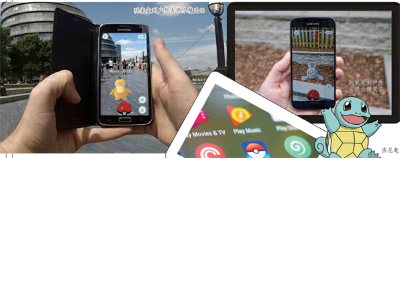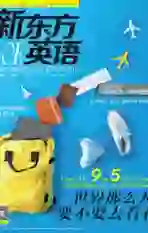PokémonGo:增强现实初体验
2016-10-09
今年7月,一款名为Pokémon Go的手机游戏风靡全球。该游戏通过运用增强现实技术,成功地将虚拟世界和真实世界结合在一起,使得玩家能够在现实世界中跑来跑去,四处寻找和捕捉游戏中的小精灵。在此之前,增强现实技术对于很多人而言还是个虚无缥缈的概念,而Pokémon Go的突然出现不仅令人眼前一亮,更令增强现实离我们的生活又近了一些。
增强现实初体验

It started as an April Fools joke. Google released a funny video that mashed up3) Google Maps and Pokémon4). The video, released on April 1, 2014, went viral, drawing more than eighteen million views in all. “We thought, ‘Why not try and make it real?” John Hanke said. Hanke is the C.E.O. of Niantic, which was then a project inside Google, developing mobile games using augmented and mixed-media5) reality.
Two years later, Hanke and his team have turned that joke into a reality. On July 6th, Niantic, which had since spun off6) from Google to become an independent company, released Pokémon Go—a game that encourages you to get out in the real world and use your mobile phone to catch Pokémon. Within two days of its release, Pokémon Go had been installed on 5.16 per cent of Android phones in the United States. In less than a week it has become the most downloaded app of the moment in Apples App Store and has started sucking7) time from our days—forty-three minutes on average, according to SimilarWeb8), more than Snapchat and Facebook. It has taken over Twitter, caused roving9) bands of nostalgic obsessives to convene on10) public spaces, and created discontent in relationships. To say it has spread like wildfire is to exaggerate the power of wildfires.
For a moment, however, put aside the sudden revival of our interest in Pokémon and consider what this spurt11) tells us about the future of software and the nature of reality—and how they integrate into what we think of as entertainment.
Augmented reality is the “boy who cried wolf” of the post-Internet world—its long been promised but has rarely been delivered in a satisfying way. Augmented reality refers to a view of the real-world environment whose elements are overlaid (or augmented) with computer-generated images and sound. (It differs from virtual reality, where the real world is replaced by complete immersion in a computer-generated space.) I first fell in love with the idea of mixed-reality games in 2011, when I tried a beta version12) of the game Shadow Cities, developed by Grey Area, a company based in Helsinki. It used locations and people from your real life, and put them in a game-like environment placed over real maps. What got me was how the game turned my real life into an alternative universe, and turned the familiar into part of a fantasy. The game involved walking, which was an added bonus for someone who has struggled with his weight.

I was hooked, and since then have been paying close attention to augmented-reality applications. None of them have gone mainstream, even those developed by IKEA and Lego13) using augmented-reality technology from Metaio, a company that was later acquired by Apple. Over the past few years, I have seen many examples of companies that combine augmented reality, advertising, and sports, but most failed to impress me, because I couldnt figure out what they were doing for me. They didnt make me more productive, like Slack14) or Quip15), and they didnt provide fun, like Facebook or Clash of Clans16).
In 2012, Niantic created an augmented-reality game for Android called Ingress. It became a cult hit, and was released on the iOS platform in 2014. Niantic was looking for its next game when the April Fools Day joke became a viral smash17). It was a sign of what people wanted. “We pitched18) that to the Pokémon Company, and what we found was that they were thinking along the same lines,” Hanke said.
Pokémon Go, which involves trying to “catch” Pikachu or Squirtle or other creatures with your smartphone, is an inherently social experience. You need to be walking around—on the streets, in public places—to catch the Pokémon. Open the app and, pretty much wherever you are, you could be alerted that there is a Pokémon in the vicinity19). The other day, I had some time to spare at the San Francisco airport, so I started looking. An animated version of Google Maps popped up on my screen, along with indications that there might be Pokémon around. The more you move around, the more creatures you find. I found only one, but I got a good workout. More important, the game made me happy; it had served a real function.

Hanke has long been interested in mapping and the interplay of our physical and digital worlds. He was the founder of Keyhole, a startup that was acquired by Google and renamed Google Earth. During our conversation, he pointed out that Google Earth was made possible by a convergence20) of digital photography, broadband networks, mapping, and the small near-Earth satellites that emerged around that time. Augmented reality, he said, is on a similar track—powerful smartphones, faster and more robust networks, a new generation of computer infrastructure, and data collection are all converging.
For those who have been believers in augmented reality, these are exciting times. Riku Suomela joined Nokia Research in 1999 and started playing around with head-mounted displays21) to experiment with augmented reality. It was clear to Suomela that it would be a while before the technology went mainstream. “I have been thinking Pokémon Go could be the product that creates the market for augmented- and mixed-reality gaming, and I am optimistic this is happening now,” Suomela—who has since started a new company, Lume Games, which competes with Niantic—said. Ville Vesterinen, the co-founder of Grey Area, said in an e-mail that “now is an ideal time” for work on “location-based games (you can call them AR if you like).” He pointed out that the number of people with mobile devices has grown considerably since his company released Shadow Cities.
For the past few days, I have been playing Pokémon Go and thinking about what it means. This weekend I went to the recently opened San Francisco Museum of Modern Art and wanted to know everything about the art and various installations, beyond what was posted on the walls. I felt as if I should be able to lift my phone and get more details on the process of the creation of the art work, rather than having to type a search term into my browser. Pokémon Go had changed my expectations on how to access information. That shift in expectation, perhaps, is the games true importance.

I keep going back to Rainbows End22), a book by the science-fiction writer Vernor Vinge23). The book, published in 2006, is about a character recovering from Alzheimers disease and learning to deal with the world around him, but what stands out is the world Vinge created. In his fictional world, computing has become miniaturized24) to such an extent that its almost invisible, woven into bodies and clothing. People interact with computers via myriad gestures. Augmented-reality interfaces replace screens as we know them, making it simple to get access to schematics for an elevator, patient records, or a drawing to fix a car.
Rainbows End was set in San Diego of 2025. That might seem too soon, but the future often arrives suddenly. And disruption often starts as a joke.
起初,这只是个愚人节的玩笑。谷歌当时发布了一段有趣的视频,里面融合了谷歌地图和《精灵宝可梦》的元素。这段于2014年4月1日发布的视频犹如病毒一样传播开来,总共获得了1800多万次的点击量。“于是我们就想,为什么不试着将其变为现实呢?”约翰·汉克说。汉克是Niantic公司的首席执行官。当时Niantic还是谷歌内部的一个项目,负责开发一些利用增强现实技术和混合媒介现实技术的手机游戏。
两年后,汉克和他的团队将这个玩笑变成了现实。7月6日,Niantic公司发布了Pokémon Go,一款鼓励玩家走进现实世界并用手机捕捉小精灵的游戏。此时的Niantic公司已经脱离谷歌,成为一家独立的公司。Pokémon Go发布的两天内,其在美国安卓手机上的安装率就达到了5.16%。不到一周,该游戏就成为时下苹果应用商店里下载量最高的应用,并开始消耗我们的时光——根据SimilarWeb的数据,人们平均每天会花43分钟的时间在这款游戏上,超过了在Snapchat和Facebook上花的时间。该游戏已经取代Twitter,使得大批四处游荡的怀旧游戏迷们纷纷聚集到公共场所,还搞得情侣关系不和。如果说这款游戏如野火般蔓延,那是夸大了野火的威力。
不过,暂且抛开我们突然对小精灵恢复兴趣这件事吧。我们还是思考一下这款手机游戏的突然大热告诉了我们哪些有关软件未来和现实本质的事,以及它们又是如何融入我们所说的娱乐中去的。
增强现实技术是后互联网时代“呼喊‘狼来了的少年”——一直以来,该技术都被认为前景不错,但却极少有令人满意的成果出现。增强现实是指在真实世界环境中的元素上叠加(或者增加)由计算机生成的图像和声音。(增强现实不同于虚拟现实,在虚拟现实中,真实的世界会被取代,用户完全浸没在由计算机生成的空间里。)我最初迷上混合现实游戏是在2011年,当时我试玩了《镜像城市》游戏的测试版。这款游戏由位于赫尔辛基的Grey Area公司开发,会利用玩家在真实生活中的地点和人物,将玩家置于如游戏般的环境中,游戏环境则叠加在真实的地图之上。这款游戏让我着迷,因为它把我的真实生活变成了一个完全不同的世界,把我熟悉的一切都变为虚幻世界的一部分。玩这款游戏需要步行,这对于正在和自身体重作斗争的人来说是个额外的福利。
我为之痴迷,从此便一直密切关注着增强现实类的应用。这些应用中没有一个进入主流视野,即便是宜家和乐高研发的应用也是如此。这两家公司使用的是德国Metaio公司研发的增强现实技术,该公司后来被苹果公司收购。过去几年间,我见过许多公司融合了增强现实技术、广告和运动的案例,但大多很难打动我,因为我压根儿没搞明白它们在为我做什么。它们既不像Slack或Quip那样使我的工作更富有成效,也不像Facebook或《部落冲突》那样能给我带来快乐。
2012年,Niantic公司为安卓系统设计了一款名为《虚拟入口》的增强现实游戏。该游戏风靡一时,十分热门,并于2014年在iOS平台上发布。当那个愚人节玩笑如病毒般疯狂传播时,Niantic公司正在寻找下一个游戏点子。而那段视频预示了人们想玩什么样的游戏。“我们将这个点子竭力推荐给Pokémon公司,结果发现他们的想法和我们一样。”汉克说。
Pokémon Go需要玩家设法用智能手机“捕捉”皮卡丘、杰尼龟或其他生物,这本身就是一种社交体验。你需要一直来回走动——到大街上、到公共场所去捕捉小精灵。基本上不论你在哪儿,只要打开游戏应用,你就有可能收到附近有小精灵出没的提醒。几天前,我在旧金山机场有些闲散的时光可供消磨,于是我开始找小精灵。一幅动漫版的谷歌地图赫然出现在我的手机屏幕上,上面附带文字指示,表明附近可能会有小精灵。你四处走动得越多,能发现的生物也就越多。虽然我只发现了一只小精灵,但我却得到了不错的锻炼。更重要的是,这款游戏让我感到快乐,它发挥了实实在在的作用。
一直以来,汉克都对地图绘制以及我们的实体世界与数字世界间的相互影响感兴趣。他是Keyhole公司的创立者,这家创业公司后来被谷歌收购,并更名为谷歌地球。在我们的交谈中,汉克指出,谷歌地球之所以能成为可能,是因为它结合了当时刚刚出现的数码摄影、宽带网络、地图绘制和小型近地卫星技术。他说,增强现实也是沿着相似的路线发展起来的——该技术结合了功能强大的智能手机、更加快捷稳定的网络、新一代计算机基础架构以及数据收集功能。
对于那些坚信增强现实技术能够成功的人而言,这些都是激动人心的时刻。里库·索梅拉于1999年加入诺基亚研究中心,开始捣鼓头戴式显示器,进行增强现实技术的实验。索梅拉清楚地知道,这项技术还要过一段时间才会成为主流。“我一直认为Pokémon Go能够成为一款为增强现实和混合现实游戏创造市场的产品,而这一切正在发生,对此我很看好。”索梅拉说道。索梅拉已经创建了一家名为Lume Games的新公司,该公司是Niantic公司的竞争对手。Grey Area公司的共同创始人维勒·韦斯特瑞南在一封电邮中表示,对于开发“基于地理定位的游戏(如果你愿意,也可以称之为AR),现在就是一个理想的时机”。他还指出,自他的公司发布《镜像城市》以来,拥有移动设备的人数一直在大幅增长。
在过去的几天里,我一直边玩Pokémon Go,边思考这款游戏的意义。这周末,我去了最近开放的旧金山现代艺术博物馆,希望能了解现代艺术和各种不同装置艺术品的方方面面,而不仅仅是那些挂在墙上的作品。我觉得我似乎可以举着手机,然后就能了解到某件艺术作品创造过程中的更多细节,而无需再往浏览器里键入关键词进行搜索。Pokémon Go已经改变了我对获取信息方式的期待。这种期待的转变或许正是这款游戏真正的重要性所在。
我最近总是重读《彩虹尽头》这部由科幻作家弗诺·文奇创作的小说。这本书于2006年出版,讲述了一个得了阿尔兹海默症的角色在康复后学习如何应对周遭世界的故事,但书中最让人印象深刻的是文奇创造出的那个世界。在他的虚构世界里,计算设备变得小到几乎看不见,并被植入到人体内,或被嵌入衣服里。人们通过五花八门的手势与计算机互动。增强现实界面替代了我们所知的显示屏,使得访问电梯图纸、病人病历或是绘制汽车维修图变得轻而易举。
《彩虹尽头》的故事设定在2025年的圣迭戈。这个时间也许看起来离我们很近,但未来常常来得猝不及防。而技术的突破往往从一个玩笑开始。
